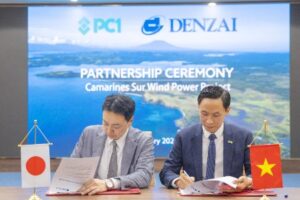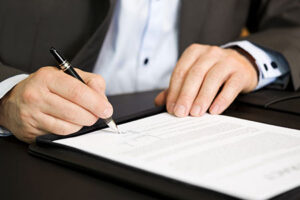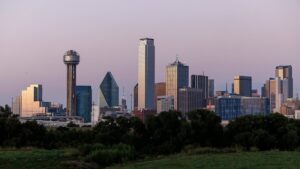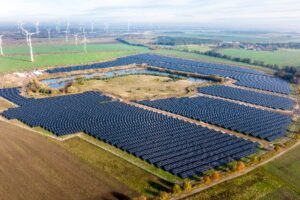How Wind Energy Produces Electricity? Harnessing the Power of the Wind

Wind energy, a sustainable and renewable power source, has gained significant prominence as a clean alternative to fossil fuels. But how does wind energy produce electricity? In this comprehensive exploration, we will uncover the intricate workings of wind turbines and the science behind converting the kinetic energy of the wind into electricity. Let’s see how wind energy produces electricity today.
1. The Gift of the Wind
Wind energy is harnessed from the natural movement of the air. Wind is essentially the movement of air masses caused by temperature and pressure differences. It’s abundant, free, and available in many parts of the world, making it an attractive source of renewable energy.
2. The Role of Wind Turbines
Wind turbines, the iconic structures dotting landscapes, are the tools that capture the wind’s energy. They consist of several key components, including the rotor, the generator, and the tower. The rotor, equipped with blades, is the heart of the wind turbine, responsible for capturing the wind’s kinetic energy.
3. Aerodynamics in Action
When the wind blows, the shape and design of the turbine blades are crucial. The airfoil design, akin to that of an aircraft wing, allows the blades to exploit the wind’s kinetic energy. As the wind rushes over the blades, it creates a difference in air pressure, generating lift.
4. Converting Kinetic Energy to Mechanical Energy
As the wind’s kinetic energy forces the blades to rotate, this mechanical energy is transmitted to the generator located in the nacelle atop the tower. The kinetic energy from the spinning blades is converted into mechanical energy in the form of shaft rotation.
5. Electromagnetic Conversion
Within the generator, mechanical energy is converted into electrical energy through electromagnetic induction. This process involves a shaft connected to the rotor, which, in turn, is connected to a series of magnets. As the shaft rotates, the magnets move past a coil of wire, generating an electric current.
6. Alternating Current (AC) Generation
Most wind turbines produce alternating current (AC), which is the form of electricity used in homes and industries. AC is generated as the rotor turns, producing cycles of alternating voltage.
7. Power Transmission
The electrical energy generated in the wind turbine is not yet suitable for consumption. It must first be transmitted and transformed to the required voltage. A transformer within the turbine adjusts the voltage to enable efficient transmission through power lines.
8. Grid Connection
The electricity generated in wind turbines is fed into an electrical grid, where it becomes part of the larger energy supply. This grid interconnects with various sources of electricity, ensuring a consistent and reliable power supply to consumers.
9. Weather-Responsive Operation
Wind turbines are equipped with technology to optimize their performance. They can adjust the angle and orientation of the blades to capture the most energy from varying wind speeds and directions. In this way, they respond to changes in the weather and wind patterns.
10. The Environmental Benefits
Wind energy is celebrated for its environmental advantages. It produces no greenhouse gas emissions, contributes to reducing air pollution, and conserves water resources. Wind turbines have a relatively low impact on the land compared to fossil fuel extraction.

Wind farm on Modou Mountain in China, image source: Unsplash
11. Challenges and Limitations
While wind energy is a sustainable source of power, it is not without challenges. Wind is an intermittent resource; it’s not always blowing, which means that wind power must be complemented with other sources for a reliable energy supply. Additionally, there are concerns about the visual and noise impacts of wind turbines.
12. Future Innovations
The field of wind energy is continually evolving. Innovations include larger and more efficient turbines, offshore wind farms, and advanced materials for turbine blades. Research and development are ongoing to make wind energy even more competitive and accessible.
13. Offshore Wind Power
In addition to onshore wind farms, offshore wind power is gaining momentum. These wind turbines are installed in bodies of water, often in the sea, to capture the strong and consistent winds found at sea. Offshore wind farms have the potential to generate significant amounts of electricity and can be positioned closer to areas with high energy demand.
14. Energy Storage Solutions
One challenge of wind energy is its intermittent nature. When the wind isn’t blowing, electricity production decreases. To address this, energy storage solutions like batteries are being integrated into wind farms. Excess electricity generated during periods of strong winds can be stored and used when wind speeds are lower.
15. Grid Integration
Integrating wind energy into existing electrical grids is a complex task. Grid operators need to balance electricity supply and demand in real-time. As wind power becomes a more substantial part of the energy mix, grid management becomes increasingly critical to ensure a stable and reliable power supply.
16. Energy Transition and Climate Goals
Wind energy is a central player in the global transition to a cleaner and more sustainable energy landscape. It plays a crucial role in reducing greenhouse gas emissions and in the fight against climate change. Many countries are setting ambitious renewable energy targets to align with international climate agreements.

Wind farm along the beach, image source: Unsplash
17. Economic Opportunities
The growth of the wind energy sector also brings economic benefits. Wind farms create jobs in manufacturing, construction, maintenance, and operation. They stimulate local economies and can revitalize rural areas with new opportunities for employment and investment.
18. Environmental Considerations
While wind energy is cleaner than fossil fuels, it is not without environmental considerations. Wind turbines can impact local wildlife, particularly birds and bats. Efforts are ongoing to mitigate these impacts and develop more wildlife-friendly wind turbine designs.
19. Wind Energy on a Global Scale
Wind energy’s success is not limited to a specific region. Countries around the world are investing in wind power, from the wind-swept plains of the United States to the coastal waters of Europe. It’s becoming a global solution to energy needs.
20. A Renewable Future
Wind energy’s role in the future of electricity generation is significant. It’s a clean and sustainable resource that aligns with the world’s growing focus on environmental sustainability and reducing carbon emissions. As technology and infrastructure continue to advance, wind energy’s capacity to meet our energy demands will only grow.
Conclusion: A Wind-Powered World
Understanding how wind energy produces electricity reveals the dynamic and ever-evolving nature of this renewable resource. It’s a testament to human innovation and our capacity to harness the forces of nature for a cleaner and more sustainable future. As wind turbines continue to populate our landscapes and seascapes, we move closer to a world where our electricity is generated by the gentle yet powerful dance of the wind.






